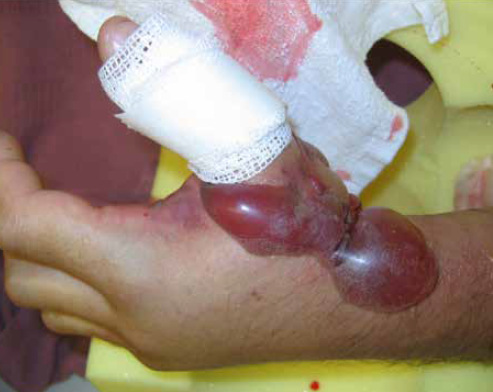What culprit created this patient’s nasty lesion?
A 45-year-old male presents with the lesion shown below. He states that the day prior, he had been doing some trail maintenance and reached into a bush to pick up some trash.
He felt a sharp pain on his hand and immediately withdrew it. The pictured wound developed over the next 24 hours. Which of the following envenomations is most likely?
- A. Bark scorpion
- B. Black widow spider
- C. Brown recluse spider
- D. Coral snake
- E. Rattlesnake
Correct answer: E. Rattlesnake
Rattlesnake venom contains tissue-destructive enzymes that cause swelling and hemorrhagic bulla formation. Local edema begins at the bite site and progresses proximally. If untreated, it may encompass large body areas. Antivenom is effective at halting the progression of edema, but does not reverse the destructive effects that have already occurred.
Although much of the injured tissue may recover over a period of days to months, tissue necrosis can also develop. Necrosis is most common if the envenomation occurs on a finger or toe.

Incorrect answer choices:
Centruroides exilicauda (bark scorpion, Choice A) venom is a neurotoxin that works via sodium channel agonism. Symptoms include local and remote pain and paresthesia, cranial nerve abnormalities, opsoclonus, drooling and uncontrollable muscle flailing. Local tissue swelling and destruction do not occur.
The primary mammalian toxin in black widow spider venom (Choice B) is alpha latrotoxin. It works via increased ion conduction in neural and endocrine cells. Clinical symptoms of envenomation include pain, local and regional sweating, and hypertension. Although a faint target lesion may transiently develop, local tissue toxicity and swelling do not occur.
Brown recluse spider venom (Choice C) contains sphingomyelinase D, which may cause delayed tissue necrosis, but does not cause early- onset edema and hemorrhagic bulla formation as seen in the case patient. The initial bite often goes unnoticed, but may be felt as a slight pin prick. Up to 90% of bites will not develop significant symptoms.
Bites that progress develop a gravity-dependent spread of erythema with a violaceous center and a blanched ring of tissue in between the two. Capillary endothelial damage, clotting and ischemia cause the violaceous center. Central ulceration and necrosis occur over the subsequent days to weeks. Lesions sometimes require skin grafting, but can also resolve without any noticeable scarring at all.
Coral snakes (Choice D) are members of the Elapidae family and contain neurotoxic venom. Local edema and bulla formation does not occur. Coral snakes do not have an efficient venom delivery apparatus the way pit vipers do, so there is a high proportion of dry bites.
Envenomed patients experience weakness that starts with the cranial nerves and causes a descending paralysis. Early antivenom can prevent progression to ventilator-dependent respiratory failure. The venom also contains myotoxins that may lead to rhabdomyolysis.









